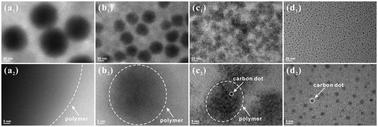How do nitrogen-doped carbon dots generate from molecular precursors? An investigation of the formation mechanism and a solution-based large-scale synthesis†
Abstract
A bottom-up method, using monoethanolamine (MEA) as both a passivation agent and a solvent, has been developed for rapid and massive synthesis of nitrogen-doped carbon dots (N-C-dots) from citric acid under heating conditions. This method requires a relatively mild temperature (170 °C) without special equipment, and affords one-pot large-scale production (39.96 g) of high-quality N-C-dots (quantum yield of 40.3%) in a few minutes (10 minutes). Significantly, an interesting formation process of N-C-dots, for the first time, has been monitored by transmission electron microscopy, ultraviolet-visible absorbance spectroscopy, photoluminescence spectroscopy, Fourier transformed infrared spectroscopy, and thermogravimetric analysis, and a corresponding formation mechanism, including polymerization, aromatization, nucleation, and growth, is proposed. It is important that the MEA-based synthesis of N-C-dots can be extended to various precursors, such as glucose, ascorbic acid, cysteine, and glutathione, which show general universality. Furthermore, the N-C-dots with strong fluorescence, excellent optical stability, and low cytotoxicity are successfully applied as fluorescent probes for bioimaging.


 Please wait while we load your content...
Please wait while we load your content...